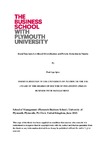Rural Non-farm Livelihood Diversification and Poverty Reduction in Nigeria
| dc.contributor.supervisor | Shepherd, Derek | |
| dc.contributor.author | Igwe, Paul Agu | |
| dc.contributor.other | Plymouth Business School | en_US |
| dc.date.accessioned | 2013-07-10T10:28:16Z | |
| dc.date.available | 2013-07-10T10:28:16Z | |
| dc.date.issued | 2013 | |
| dc.identifier | 256308 | en_US |
| dc.identifier.uri | http://hdl.handle.net/10026.1/1561 | |
| dc.description.abstract |
The aim of this research is to provide analysis of the rural non-farm sector in Nigeria by investigating inter-linkages between farm and non-farm activities. By critical analysis using quantitative and qualitative research methods to investigate farm and non-farm sectors, the research attempts to reveal the complex linkages between these activities undertaken by rural households. The analysis employs household surveys aimed at collecting primary data undertaken to investigate various aspects of rural livelihoods including sources of income, employment, diversification and determinants of household income. The research provides analysis of Rural Micro and Small Enterprises (RMSEs) in the non-farm sector. It investigates the sources of rural livelihoods, which are primarily based on farming activities. However, farming in this area is still carried out by about 80 percent of households in a traditional subsistence system with crude implements and in scattered plots of about 2.0 hectares or less. This subsistence farming system has resulted in increasing changes in decision making, along with dynamic processes of socio-economic and cultural changes including assets and resources which households depend on for their survival. Diversification of income activities has become an important aspect of rural livelihoods due to continued low agricultural income and output. Non-farm income activities have the potential to reduce rising rural unemployment, providing more income opportunities for young people, women and other vulnerable groups. It can provide capital for investment in child education, home improvement, asset formation and on-farm innovation or expansion. This research argues for an integrated approach towards rural development and poverty reduction through the promotion of both agriculture and non-agricultural sectors. Analysis of household income structure and determinants indicate that non-farm income accounts for about 44% of total household income and non-farm income has become an important source of capital for on-farm and off-farm investment. Ownership of non-farm enterprise, household labour force, level of education, age, farm size (land), financial capital (level of savings) and access to basic infrastructure are the main determinants of household income. Using disaggregated and distributional data the study found variations in effect of the various factors on household income on different groups of households. | en_US |
| dc.language.iso | en | en_US |
| dc.publisher | University of Plymouth | en_US |
| dc.subject | Rural Micro and Small Enterprises | en_US |
| dc.title | Rural Non-farm Livelihood Diversification and Poverty Reduction in Nigeria | en_US |
| dc.type | Thesis | |
| plymouth.version | Full version | en_US |
| dc.identifier.doi | http://dx.doi.org/10.24382/4652 | |
| dc.identifier.doi | http://dx.doi.org/10.24382/4652 |
Files in this item
This item appears in the following Collection(s)
-
01 Research Theses Main Collection
Research Theses Main


